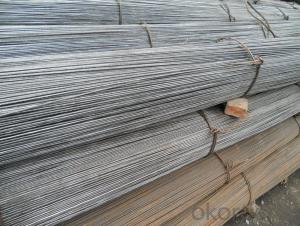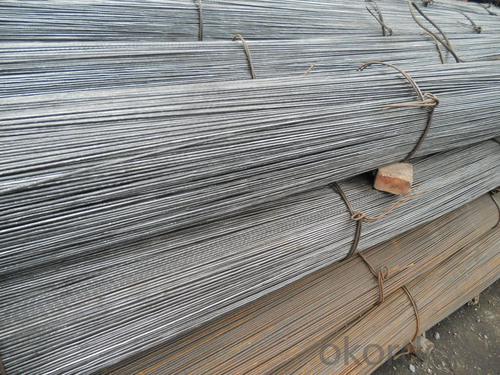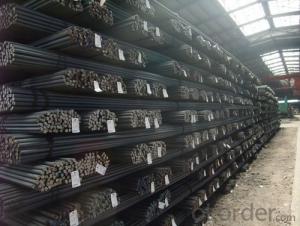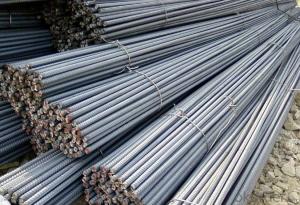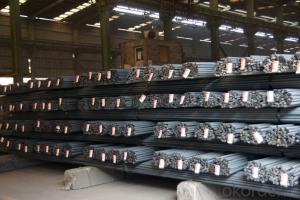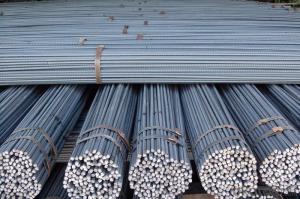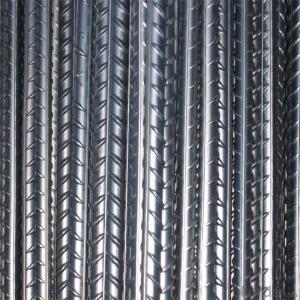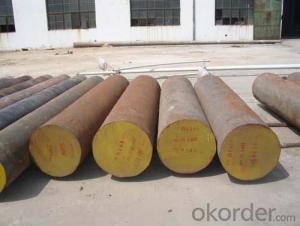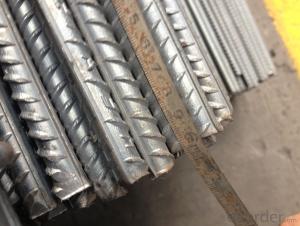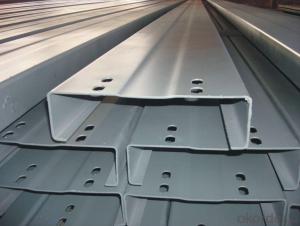KS Steel Deformed Bar SD400 Made in China
- Loading Port:
- Tianjin
- Payment Terms:
- TT or LC
- Min Order Qty:
- 24 m.t.
- Supply Capability:
- 18000 m.t./month
OKorder Service Pledge
OKorder Financial Service
You Might Also Like
Product Description:
OKorder is offering KS Steel Deformed Bar SD400 Made in China at great prices with worldwide shipping. Our supplier is a world-class manufacturer of steel, with our products utilized the world over. OKorder annually supplies products to European, North American and Asian markets. We provide quotations within 24 hours of receiving an inquiry and guarantee competitive prices.
Product Applications:
KS Steel Deformed Bar SD400 Made in China are ideal for structural applications and are widely used in the construction of buildings and bridges, and the manufacturing, petrochemical, and transportation industries.
Product Advantages:
OKorder's KS Steel Deformed Bar SD400 Made in China are durable, strong, and resist corrosion.
Main Product Features:
· Premium quality
· Prompt delivery & seaworthy packing (30 days after receiving deposit)
· Corrosion resistance
· Can be recycled and reused
· Mill test certification
· Professional Service
· Competitive pricing
Product Specifications:
Standard | GB | HRB400 | ||||||||
Diameter | 6mm,8mm,10mm,12mm,14mm,16mm,18mm,20mm, 22mm,25mm,28mm,32mm,36mm,40mm,50mm | |||||||||
Length | 6M, 9M,12M or as required | |||||||||
Place of origin | Hebei, China mainland | |||||||||
Advantages | exact size, regular package, chemical and mechanical properties are stable. | |||||||||
Type | Hot rolled deformed steel bar | |||||||||
Brand name | DRAGON | |||||||||
Grade | Technical data of the original chemical composition (%) | |||||||||
C | Mn | Si | S | P | V | |||||
HRB400 | ≤0.25 | ≤1.60 | ≤0.80 | ≤0.045 | ≤0.045 | 0.04-0.12 | ||||
Physical capability | ||||||||||
Yield Strength (N/cm²) | Tensile Strength (N/cm²) | Elongation (%) | ||||||||
≥400 | ≥570 | ≥14 | ||||||||
Packaging & Delivery:
Packaging Detail: products are packed in bundle and then shipped by container or bulk vessel, deformed bar is usually naked strapping delivery, when storing, please pay attention to moisture proof. The performance of rust will produce adverse effect.
Each bundle weight: 2-3MT, or as required
Payment term: TT or L/C
Delivery Detail: within 45 days after received advanced payment or LC.
Label: to be specified by customer, generally, each bundle has 1-2 labels
Trade terms: FOB, CFR, CIF
FAQ:
Q1: Why buy Materials & Equipment from OKorder.com?
A1: All products offered byOKorder.com are carefully selected from China's most reliable manufacturing enterprises. Through its ISO certifications, OKorder.com adheres to the highest standards and a commitment to supply chain safety and customer satisfaction.
Q2: How do we guarantee the quality of our products?
A2: We have established an advanced quality management system which conducts strict quality tests at every step, from raw materials to the final product. At the same time, we provide extensive follow-up service assurances as required.
Q3: How soon can we receive the product after purchase?
A3: Within three days of placing an order, we will begin production. The specific shipping date is dependent upon international and government factors, but is typically 7 to 10 workdays.
Images:
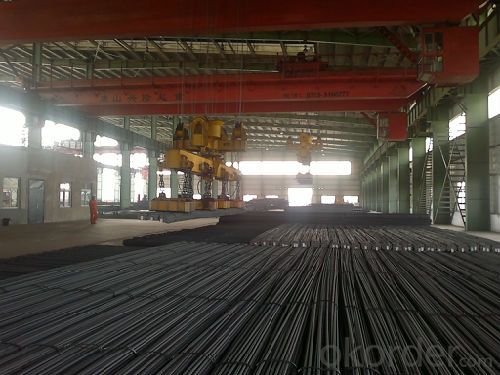
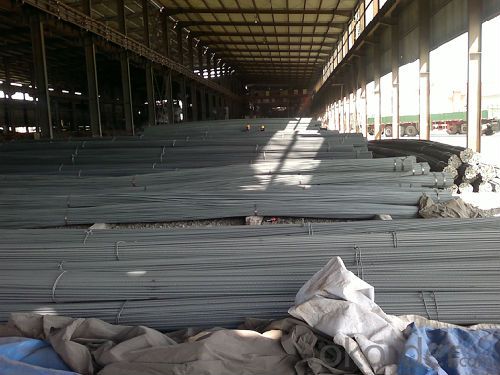
- Q: What is the role of steel rebars in pile foundation construction?
- Pile foundation construction heavily relies on steel rebars, as they serve a vital purpose. These foundations are designed to shift the weight of a structure to deeper layers of soil or rock, ensuring stability and preventing any settling. Steel rebars are utilized in this process to reinforce the concrete piles, thereby increasing their strength and durability. The primary function of steel rebars within pile foundation construction is to provide tensile strength to the concrete. Although concrete is strong under compression, it lacks the ability to withstand tension. By incorporating steel rebars into the concrete, it creates a reinforced structure capable of withstanding both compression and tension forces. In addition, steel rebars play a significant role in preventing cracking and providing structural integrity to the piles. As the piles are subjected to various loads, including vertical and lateral forces, the rebars distribute these loads evenly, preventing any cracking or failure of the concrete under stress. This ensures the stability and longevity of the pile foundation. Moreover, steel rebars contribute to the overall performance of the piles. They enhance the load-carrying capacity of the foundation, enabling it to support heavier structures or loads. The rebars also improve the resistance of the piles against external factors such as earthquakes, wind loads, and soil movement. In summary, steel rebars are essential in pile foundation construction, providing tensile strength, preventing cracking, and enhancing the overall performance and durability of the foundation. Their utilization ensures efficient load transfer and stability, making them an integral component in the construction of robust and dependable structures.
- Q: How are steel rebars protected from moisture during storage?
- Steel rebars are typically protected from moisture during storage by applying a protective coating, such as a layer of corrosion-resistant paint or a water-repellent film. Additionally, rebars may be stored in covered or enclosed areas to shield them from direct exposure to rain or other sources of moisture.
- Q: How are steel rebars used in the construction of airports?
- To ensure the overall strength and stability of various concrete structures in airport construction, steel rebars are extensively utilized. These rebars, also known as reinforcing bars, are typically made of steel and are strategically placed within concrete elements like beams, columns, slabs, and foundations. In the context of airport construction, rebars primarily serve to reinforce the concrete used in runways, taxiways, and aprons. Runways, subjected to heavy loads and constant aircraft movements, require significant reinforcement to withstand immense pressure and prevent cracking or structural failure. By embedding steel rebars within the concrete, its tensile strength is enhanced, enabling it to bear heavy loads without compromising the runway's integrity. Similarly, taxiways and aprons, which accommodate aircraft taxiing, parking, and refueling, also rely on steel rebars for reinforcement. These areas experience continuous vehicle and equipment traffic, making them susceptible to wear and tear. By incorporating rebars in the concrete, these surfaces can endure constant stress and weight, ensuring durability and longevity. Apart from runways, taxiways, and aprons, steel rebars are also utilized in constructing other airport structures such as terminal buildings, control towers, hangars, and parking facilities. These structures necessitate strong foundations and sturdy frames to support the building's weight and withstand environmental factors like wind and seismic forces. Steel rebars are employed to reinforce the concrete foundations, columns, and beams, providing the necessary strength and stability. Overall, steel rebars play a vital role in airport construction by enhancing the structural integrity and durability of various concrete elements. They ensure airport facilities can endure heavy loads, constant traffic, and adverse weather conditions associated with air travel, guaranteeing the safety and efficiency of airport operations.
- Q: What is the effect of steel rebars on the formwork design?
- The formwork design in construction projects is significantly impacted by steel rebars. These reinforcement bars, also known as rebars, play a crucial role in providing strength and stability to concrete structures. One important aspect influenced by steel rebars in formwork design is the proper positioning and spacing of the rebars within the formwork. To ensure the structural integrity of the concrete element, the formwork must be designed to accommodate the rebars and allow for their correct placement. This may involve creating openings or recesses in the formwork to facilitate the passage of the rebars. The presence of steel rebars also affects the size and dimensions of the formwork. As the rebars occupy space within the concrete element, the formwork needs to be adjusted accordingly to accommodate these additional materials. This may require increasing the size or thickness of the formwork to provide the desired concrete cover over the rebars. Another factor influenced by steel rebars in formwork design is the consideration of the weight and load-bearing capacity of the formwork system. The addition of steel rebars significantly increases the weight of the concrete structure, necessitating the design of formwork that can withstand this additional load. This may involve using stronger and more durable materials for the formwork and ensuring proper bracing and support. Furthermore, the presence of steel rebars can impact the formwork construction process. The formwork design must carefully consider the installation and removal of the rebars without compromising the integrity of the formwork system. This may involve incorporating removable sections or panels in the formwork design to facilitate the placement and removal of the rebars. In conclusion, steel rebars have a profound impact on formwork design in construction projects. Proper consideration and planning are necessary to ensure the correct positioning, spacing, and support of rebars within the formwork. The presence of rebars also affects the size, dimensions, weight, and construction process of the formwork system. Overall, the successful construction of durable and structurally sound concrete elements relies on the proper integration of steel rebars within the formwork design.
- Q: Are steel rebars suitable for reinforcement in tunnels?
- Yes, steel rebars are suitable for reinforcement in tunnels. Steel rebars have high tensile strength and provide excellent structural support, making them an ideal choice for reinforcing concrete in tunnels. They help enhance the structural integrity and durability of the tunnel, ensuring it can withstand the loads and stresses it will be subjected to during its lifespan.
- Q: Can steel rebars be used in structures with high resistance to creep?
- Yes, steel rebars can be used in structures with high resistance to creep. Steel rebars are commonly used in reinforced concrete structures and provide strength and durability to the overall structure. Creep is the gradual deformation of a material under constant stress over time. While steel does exhibit some creep, it is considered to have a low creep rate compared to other materials such as concrete or timber. Additionally, the use of rebars in reinforced concrete structures can help distribute the load and minimize the effects of creep by adding stiffness and reducing the overall stress on the concrete. Therefore, steel rebars can be effectively used in structures with high resistance to creep when designed and installed properly.
- Q: How are steel rebars tested for quality and strength?
- Steel rebars are tested for quality and strength through various methods such as visual inspection, dimensional checks, chemical composition analysis, and mechanical testing. Visual inspection ensures that there are no visible defects or irregularities on the surface. Dimensional checks verify that the rebars meet the specified size and shape requirements. Chemical composition analysis determines the elemental composition of the steel, ensuring it meets the required standards. Mechanical testing involves subjecting samples to tension, bending, or impact tests to assess their strength and confirm they can withstand the expected loads.
- Q: How do steel rebars perform in corrosive environments?
- Steel rebars perform well in corrosive environments due to their inherent resistance to corrosion. The presence of a protective oxide layer on the surface of steel rebars prevents direct contact with corrosive elements. Additionally, rebars can be further protected through the application of corrosion-resistant coatings or by using stainless steel rebars. These measures enhance their durability and ensure their long-term performance in corrosive environments, such as marine or industrial settings.
- Q: How do steel rebars contribute to the overall structural performance of a building?
- The overall structural performance of a building is greatly enhanced by steel rebars. These reinforced steel bars are primarily utilized in concrete construction, providing the structure with strength and stability. To begin with, the addition of steel rebars reinforces the concrete by increasing its tensile strength. While concrete is highly resistant to compression forces, it lacks strength when it comes to tension. By introducing steel rebars, which possess exceptional tensile strength, the resulting composite material becomes significantly stronger and more resistant to bending or cracking under pressure. Additionally, the utilization of rebars improves the longevity and durability of the building. Concrete structures are subjected to various forces such as wind, earthquakes, and heavy loads. Steel rebars act as a network of reinforcement, effectively distributing these forces throughout the concrete and preventing localized damage. This reinforcement reduces the risk of structural failure, ensuring that the building can withstand the test of time and environmental conditions. Moreover, rebars contribute to the overall stability of the structure by reinforcing concrete columns, beams, and slabs. This reinforcement enhances their load-bearing capacity, allowing the building to support heavier loads without excessive deflection or collapse. The increased stability provided by the rebars also enables more flexible and innovative architectural designs, as they offer the necessary structural support for complex and unique building shapes. Furthermore, steel rebars are crucial in areas prone to earthquakes. The ductility and flexibility of steel enable it to absorb and dissipate the energy generated during seismic events. This prevents the building from sustaining severe damage and helps it maintain its structural integrity, minimizing risks to occupants. Overall, steel rebars play a vital role in improving the overall structural performance of a building by enhancing its strength, durability, stability, and resistance to various forces. Their utilization ensures that the structure remains safe, long-lasting, and capable of withstanding the demands placed upon it, making them an indispensable component in modern construction.
- Q: Can steel rebars be used in structures with high aesthetic requirements?
- Indeed, structures with high aesthetic standards can make use of steel rebars. Although steel rebars are mainly employed for their robustness and longevity, they can also be fashioned and integrated in a manner that satisfies aesthetic necessities. Rebars have the potential to be molded, curved, or even coated to align with the desired visual appeal of the structure. Furthermore, they can be concealed within the framework or concealed under alternate materials to preserve a pristine and visually captivating facade. Through meticulous forethought and design, steel rebars can be effectively employed in structures with demanding aesthetic prerequisites without compromising their functionality or visual allure.
Send your message to us
KS Steel Deformed Bar SD400 Made in China
- Loading Port:
- Tianjin
- Payment Terms:
- TT or LC
- Min Order Qty:
- 24 m.t.
- Supply Capability:
- 18000 m.t./month
OKorder Service Pledge
OKorder Financial Service
Similar products
Hot products
Hot Searches
Related keywords
